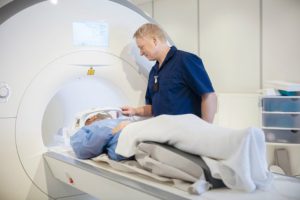Which is More Effective: MRI or CT?
In the world of radiology, both the CT scan and the MRI are very common procedures that assist physicians in diagnosis and treatment.


In the world of radiology, both the CT scan and the MRI are very common procedures that assist physicians in diagnosis and treatment.
Both are highly effective, with technology only continuing to advance and improve with time. The differences between the operation of the MRI and CT are fairly significant, but both produce detailed images that give a closer look at concerns within the body.
Whether your medical practitioner recommends an MRI or a CT scan, they will do so based on what will provide the best results and be most appropriate (and safe) for your particular health needs.
A Closer Examination of the CT Scan
A CT scan, short for computerised tomography, belongs to the x-ray family. The basic x-ray uses ionising radiation to generate images of the body’s interior. Going a step further, the CT scan is an x-ray machine that rotates, creating cross-section scans of the body. When these scans are combined together, a 3D image is developed that can give valuable insight and information to physicians and radiologists.
The CT scan uses a higher level of ionising radiation than the general x-ray. However, at quality practices like Vision XRAY, low-dose radiation technology has been implemented successfully, minimising exposure and risk to patients. CT scans are a painless procedure, lasting less than half an hour to complete. Alongside the scan itself, CT may occasionally require the administration of a contrast dye, a pharmaceutical liquid that helps highlight certain regions of the body during the procedure.
A Closer Look at the MRI
The biggest difference between the CT and MRI, or magnetic resonance imaging, is the lack of ionising radiation used. The MRI scan employs an electric current which sends radio waves through coils to produce high-quality pictures of the body. The signals generated by the radio waves create, like the CT scan, cross-section images that offer a 3-dimensional vision. Compared to the CT scan, an MRI appointment lasts longer, as the technology produces images more slowly.
So, Which is More Effective?
It is fair to say that the scan which is most effective is that which will provide the best possible images for a patient while also protecting their health to the highest degree. Whether that option is MRI or CT scan is the decision of the medical doctor and radiologist. Both scans have their value and are tremendous resources, but the CT and MRI have different strengths and applications.
MRIs are usually the best choice for scans involving the ligaments, tendons, and spinal cord, as MRI images typically offer more density and intricacy. This is especially useful when examining soft tissue for abnormalities, or diagnosing problems in these complex areas.
CT scans are good for zeroing in on a specific region of the body. They are used frequently for injuries or complaints involving the head, chest, abdomen and pelvis, particularly when fractures or bone involvement is suspected. CT scans are the procedure of choice for examining internal organs or seeking out tumours, blood clots, abscesses, or masses. CT scans are often used during surgical procedures, such as a tissue biopsy, as they assist with delicate internal navigation.
A Sydney Radiologist You Can Trust
At Vision XRAY, you can feel secure in the knowledge that our team is dedicated first and foremost to your health, safety, and comfort. In every situation, we aim to select the procedure which will produce the very best results at minimal risk. If you have any questions regarding MRI, CT, or any of our offerings here at Vision XRAY, do not hesitate to get in touch.
Read our articles and FAQs
We’re delighted to provide updates on the latest medical imaging technology and answer your most frequently asked questions about our services.









